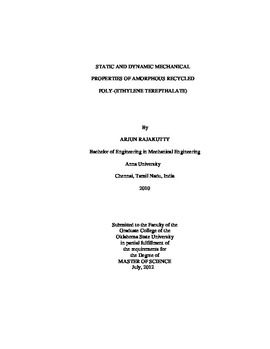| dc.contributor.advisor | Hanan, Jay C. | |
| dc.contributor.author | Rajakutty, Arjun | |
| dc.date.accessioned | 2014-04-17T19:53:44Z | |
| dc.date.available | 2014-04-17T19:53:44Z | |
| dc.date.issued | 2012-07-01 | |
| dc.identifier.uri | https://hdl.handle.net/11244/10036 | |
| dc.description.abstract | Polymers are among the largest used materials today in the world. PET has a significant market share among all the other polymers. More than 90% of plastic bottles made in the world are from PET. With this huge amount of material being used, the impact on the environment in the form of increasing landfills and carbon dioxide emissions has also been high. Hence the need to recycle PET and reuse it has been a topic of interest over the last few years. However, loss in properties of recycled PET (rPET) has been a concern and it is still considered secondary to virgin PET. This work was aimed at studying the mechanical properties of rPET and comparing these properties with those from virgin PET. The dynamic behavior of PET was part of this study. Apart from studying the mechanical properties of rPET, several other tests were performed to study thermal properties, crystallinity, color measurements (yellowing), friction behavior and also to determine structural performance of blow molded bottles. Material properties obtained from experimental results were used as input for Finite Element simulations. The findings and results from this research have provided a framework to understand the mechanical properties of rPET. The method of tensile testing using the custom fixture was an efficient means of determining bulk mechanical properties. rPET was found to have properties similar to virgin PET resins with dynamic measurements showing the greatest differences near 100 mm/min. The dynamic properties with increasing strain rates generally fit power law or exponential curves. DSC measurements along the preform helped to understand the crystallinity distribution and validate the new tensile sample injection method. Strain induced crystallization was also observed. Color measurements provided a good indication of the yellowness index values in rPET and changes in these values on addition of coloring agents. Top load and hoop strength measurements on bottles showed rPET performing similar to virgin PET resins. Using rPET was found to give considerable energy savings. All these results provided encouragement for rPET to be considered for industrial applications on a large scale, and that it will have a positive impact on the environment in the long run. | |
| dc.format | application/pdf | |
| dc.language | en_US | |
| dc.publisher | Oklahoma State University | |
| dc.rights | Copyright is held by the author who has granted the Oklahoma State University Library the non-exclusive right to share this material in its institutional repository. Contact Digital Library Services at lib-dls@okstate.edu or 405-744-9161 for the permission policy on the use, reproduction or distribution of this material. | |
| dc.title | Static and Dynamic Mechanical Properties of Amorphous Recycled Poly-(Ethylene Terepthalate) | |
| dc.type | text | |
| dc.contributor.committeeMember | Kalkan, Kaan A. | |
| dc.contributor.committeeMember | Vaidyanathan, Ranji K. | |
| osu.filename | Rajakutty_okstate_0664M_12261.pdf | |
| osu.college | Engineering, Architecture, and Technology | |
| osu.accesstype | Open Access | |
| dc.description.department | Mechanical & Aerospace Engineering | |
| dc.type.genre | Thesis | |
| dc.subject.keywords | mechanical behavior | |
| dc.subject.keywords | mechanical properties | |
| dc.subject.keywords | pet | |
| dc.subject.keywords | recycled pet | |
| dc.subject.keywords | static and dynamic | |
| dc.subject.keywords | strain rate | |
